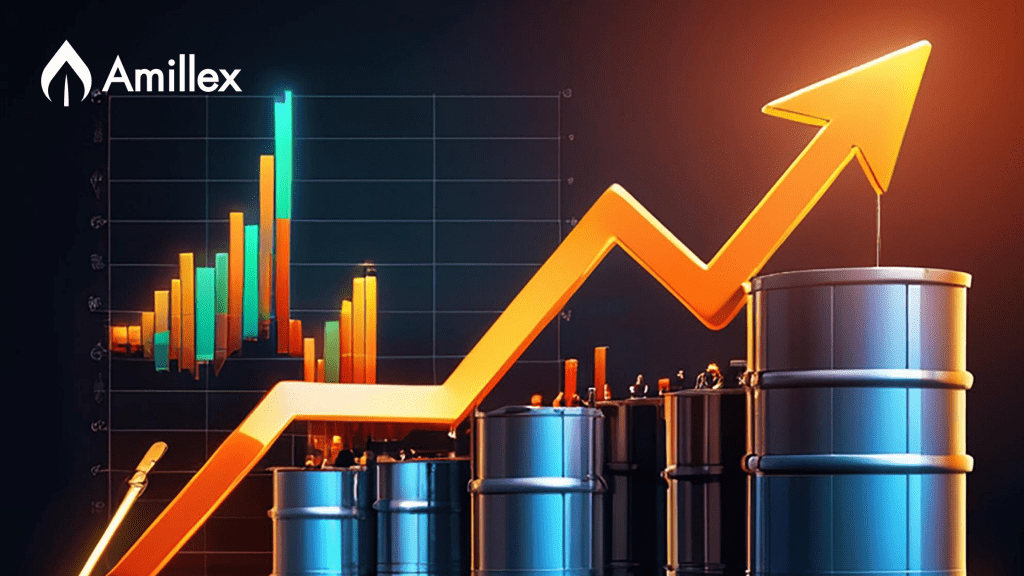
CFD 거래(차액결제거래)는 금융 시장에서 가장 인기 있는 거래 형태 중 하나가 되었으며, 거래자는 기초 자산을 소유하지 않고도 광범위한 자산 클래스에 접근할 수 있습니다. 이 거래 메커니즘은 유연성, 레버리지, 상승 및 하락 시장 모두에서 수익을 낼 수 있는 능력으로 인해 초보자와 노련한 거래자 모두에게 어필합니다.
이 포괄적인 가이드에서는 외환, 주식, 상품, 지수, 채권, 암호화폐를 포함하여 CFD 거래에 사용할 수 있는 주요 자산 클래스를 살펴봅니다. 거래를 막 시작했든 이미 거래 경험이 있든, 이 글은 CFD가 작동하는 방식과 이와 관련된 잠재적인 이점과 위험에 대한 귀중한 통찰력을 제공합니다.
CFD(차액결제거래)란 무엇인가요?
CFD 또는 차액 계약은 거래자가 자산 자체를 실제로 소유하지 않고도 다양한 자산 클래스의 가격 변동에 대해 추측할 수 있도록 하는 금융 파생 상품입니다. CFD는 본질적으로 거래자와 브로커가 계약이 개설되는 시점과 마감되는 시점 사이의 자산 가치 차이를 교환하기로 하는 계약입니다.
CFD는 가격이 상승할 것으로 생각되면 롱 포지션(매수)을 취하고, 가격이 하락할 것으로 생각되면 숏 포지션(매도)을 취할 수 있도록 합니다. 상승과 하락 시장 움직임 모두에서 이익을 얻을 수 있는 능력은 CFD를 시장 변동성을 활용하고자 하는 거래자에게 매력적인 옵션으로 만듭니다.
CFD는 또한 레버리지를 제공하여 트레이더가 더 적은 자본으로 더 큰 포지션을 통제할 수 있습니다. 레버리지는 수익을 증폭시킬 수 있지만, 잠재적 손실도 증가시킬 수 있으므로 위험 관리가 CFD 거래의 중요한 측면이 됩니다.

CFD 거래를 위한 주요 자산 클래스 탐색
외환시장(Forex)
외환 시장은 세계에서 가장 크고 유동적인 금융 시장으로, 평균 일일 거래량이 $6조를 초과합니다. 외환 거래는 한 통화를 다른 통화로 교환하는 것을 포함하며, 통화 쌍의 가치는 이자율, 지정학적 사건, 경제 지표를 포함한 다양한 요인으로 인해 변동합니다.
외환 시장에서 CFD 거래를 통해 트레이더는 EUR/USD, GBP/USD, USD/JPY와 같은 통화 쌍의 가격 변동에 대해 추측할 수 있으며, 실제로 통화를 교환하지 않아도 됩니다. 외환 CFD를 통해 트레이더는 좁은 스프레드, 레버리지, 주 5일, 하루 24시간 거래할 수 있는 능력의 이점을 누릴 수 있습니다.
외환 CFD의 주요 이점:
- 높은 유동성: 외환 시장의 엄청난 규모 덕분에 거래가 최소한의 슬리피지로 신속하게 실행될 수 있습니다.
- 레버리지: 외환 CFD는 높은 레버리지를 제공하므로, 거래자는 비교적 적은 자본으로 큰 포지션을 통제할 수 있습니다.
- 글로벌 시장에 대한 접근성: 외환 CFD는 글로벌 통화에 대한 노출을 제공하여 거래자가 거시경제 동향과 지정학적 사건을 활용할 수 있도록 해줍니다.
위험:
- 높은 변동성: 외환 시장은 뉴스 이벤트나 경제 데이터 발표에 따라 가격이 급격하게 변동하면서 매우 변동성이 심할 수 있습니다. 이러한 변동성은 수익 기회를 제공하지만, 상당한 손실 위험도 증가시킵니다.
주식 CFD
주식 CFD를 통해 트레이더는 실제 주식을 소유하지 않고도 개별 회사 주식의 가격 변동에 대해 추측할 수 있습니다. 이러한 형태의 거래는 트레이더에게 상당한 자본을 투자할 필요 없이 가격 변동에서 수익을 낼 수 있는 기회를 제공하기 때문에 점점 더 인기를 얻고 있습니다.
주식 CFD를 거래할 때, 거래자는 주가가 오를 것으로 생각되면 롱(매수)을 하거나 주가가 떨어질 것으로 생각되면 숏(매도)을 할 수 있습니다. 주식 가치가 상승할 때만 수익을 실현하는 기존 주식 거래와 달리, 주식 CFD는 거래자가 상승과 하락 시장 움직임 모두에서 수익을 낼 수 있도록 합니다.
주식 CFD의 주요 이점:
- 소유권 없음: 트레이더는 주식을 소유하는 데 따르는 복잡성과 비용 없이 주가 움직임을 추측할 수 있습니다.
- 레버리지: 주식 CFD는 레버리지를 제공하여 거래자가 전통적인 주식 거래보다 더 큰 포지션을 취할 수 있게 해줍니다.
- 공매도: 주식 CFD를 통해 거래자는 공매 포지션을 취해 가격 하락으로부터 수익을 얻을 수 있습니다.
위험:
- 배당금과 기업 활동: 주식 CFD는 가격 변동에 대한 노출을 제공하지만, 트레이더는 실제 주식 소유권과 같이 배당금을 받거나 투표권을 갖지 않습니다. 주식 분할이나 배당금과 같은 기업 활동도 CFD 포지션에 영향을 미칠 수 있습니다.
- 야간 수수료: 주식 CFD 포지션을 야간에 보유하면 수수료가 발생할 수 있으며, 이는 시간이 지남에 따라 수익이 줄어들 수 있습니다.
상품 CFD
금, 석유, 농산물과 같은 상품은 세계 경제를 움직이는 필수적인 원자재입니다. CFD를 통한 상품 거래는 거래자가 물리적 상품을 소유하지 않고도 이러한 중요한 자산의 가격 변동에 대해 추측할 수 있게 해줍니다.
상품 CFD는 상품 시장의 본질적인 변동성으로 인해 거래자들에게 인기가 있습니다. 상품 가격은 공급 및 수요 요인, 지정학적 긴장, 기상 조건 및 거시경제적 추세에 따라 극적으로 변동할 수 있습니다.
상품 CFD의 주요 이점:
- 다각화: 상품 CFD는 다양한 자산 클래스에 대한 노출을 제공하여 거래자가 인플레이션에 대한 헤지 또는 포트폴리오 다각화를 할 수 있도록 해줍니다.
- 글로벌 영향: 상품 가격은 자연 재해, 정치적 불안정, 생산 수준의 변화와 같은 글로벌 이벤트의 영향을 받습니다. 이는 트레이더가 시장 움직임을 활용할 수 있는 기회를 제공합니다.
- 레버리지: 다른 CFD와 마찬가지로 상품 CFD도 레버리지를 제공하여 거래자가 적은 자본으로 큰 포지션을 통제할 수 있습니다.
위험:
- 높은 변동성: 상품 시장은 자연 재해나 지정학적 갈등과 같은 예상치 못한 사건으로 인해 상당한 가격 변동을 겪을 수 있으며, 이는 큰 이익이나 손실로 이어질 수 있습니다.
- 보관 및 운송 비용: 거래자는 물리적 상품을 보관하거나 운송하는 데 따른 물류에 대해 걱정할 필요는 없지만 이러한 요소는 상품 CFD의 가격에 영향을 미칠 수 있습니다.
지수 및 채권 CFD
지수 CFD는 트레이더가 단일 상품을 거래하여 S&P 500, FTSE 100 또는 DAX 30과 같은 전체 주식 시장의 성과를 추측할 수 있도록 합니다. 개별 주식에 집중하는 대신 지수 CFD는 특정 시장 또는 부문 내 주식 그룹의 전반적인 성과를 나타냅니다.
반면 채권 CFD는 실제 채권을 소유할 필요 없이 정부 또는 기업 채권에 대한 노출을 제공합니다. 채권은 정부 또는 기업이 자본을 조달하기 위해 발행하는 채무 증서이며, 그 가격은 이자율과 경제 상황에 따라 변동합니다.
지수와 채권 CFD의 주요 이점:
- 광범위한 시장 노출: 지수 CFD는 시장이나 부문의 전반적인 성과에 노출되는 방법을 제공하여 개별 주식을 분석할 필요성을 줄여줍니다.
- 헤지: 거래자는 지수 CFD를 사용하여 시장 하락에 대비하거나 포트폴리오를 다각화할 수 있습니다.
- 레버리지: 지수와 채권 CFD는 모두 레버리지를 제공하므로, 거래자는 적은 자본으로 더 큰 포지션을 통제할 수 있습니다.
위험:
- 시장 상관관계: 지수 CFD는 전체 시장과 높은 상관관계를 가지고 있으므로 전체 시장이 하락세를 보이면 지수 CFD의 가치도 하락합니다.
- 이자율 민감도: 채권 CFD는 이자율 변화에 민감하며, 이자율이 상승하면 채권 가격은 일반적으로 하락합니다.
암호화폐 CFD
암호화폐는 최근 몇 년 동안 새롭고 혁신적인 자산 클래스로 상당한 주목을 받았습니다. 비트코인, 이더리움, 리플과 같은 암호화폐는 블록체인 기술을 사용하여 분산형 네트워크에서 작동합니다. 암호화폐 CFD를 통해 트레이더는 실제 코인을 소유하지 않고도 디지털 통화의 가격 변동에 대해 추측할 수 있습니다.
암호화폐 시장은 극심한 변동성으로 유명하며, 가격은 종종 짧은 시간 내에 극적으로 변동합니다. 암호화폐 CFD는 거래자에게 지갑을 설정하거나 복잡한 거래소를 탐색할 필요 없이 이러한 가격 변동에서 수익을 낼 수 있는 기회를 제공합니다.
암호화폐 CFD의 주요 이점:
- 변동성: 암호화폐의 높은 변동성은 CFD 거래를 통해 수많은 수익을 낼 수 있는 기회를 제공합니다.
- 레버리지: 암호화폐 CFD는 레버리지를 제공하여 거래자가 잠재 수익을 확대할 수 있도록 합니다.
- 지갑이 필요 없습니다. 암호화폐 CFD 거래에서는 디지털 지갑을 설정 및 관리할 필요가 없고, 거래소 관련 보안 문제를 처리할 필요도 없습니다.
위험:
- 시장 변동성: 변동성은 수익 기회를 창출하지만, 상당한 손실의 위험도 증가시킵니다. 트레이더는 갑작스럽고 예상치 못한 가격 변동에 대비해야 합니다.
- 규제 불확실성: 암호화폐를 둘러싼 규제 환경은 여전히 변화하고 있으며, 규정 변경은 암호화폐 CFD의 가치에 영향을 미칠 수 있습니다.
자산 클래스 간 CFD 거래의 장점

CFD 거래는 다양한 자산 클래스의 거래자에게 매력적인 옵션이 되는 몇 가지 주요 이점을 제공합니다.
- 레버리지: CFD는 거래자에게 비교적 적은 자본으로 큰 포지션을 통제할 수 있는 능력을 제공합니다. 이는 잠재적 이익과 잠재적 손실을 모두 증폭시켜 거래자가 레버리지를 신중하게 사용하는 것이 필수적입니다.
- 글로벌 시장에 대한 접근성: CFD 거래자는 단일 플랫폼을 통해 광범위한 자산 클래스와 글로벌 시장에 접근할 수 있어 다양한 경제 부문에 대한 다각화와 노출이 가능합니다.
- 상승 및 하락 시장에서 수익을 창출할 수 있는 능력: CFD 거래의 가장 중요한 이점 중 하나는 자산에 대해 롱(매수) 또는 숏(매도)할 수 있는 능력입니다. 즉, 트레이더는 상승 및 하락 가격 변동 모두에서 수익을 창출할 수 있습니다.
- 기초 자산에 대한 소유권 없음: CFD 거래자는 기초 자산을 소유하지 않으므로 상품의 물리적 보관이나 주식의 의결권과 같은 소유와 관련된 복잡성과 비용이 없습니다.
CFD 거래의 위험 및 고려 사항
CFD 거래는 여러 가지 이점을 제공하지만, 고유한 위험도 따릅니다.
- 레버리지 위험: 레버리지는 이익과 손실을 모두 증폭시킬 수 있습니다. 트레이더는 적은 자본으로 큰 포지션을 통제할 수 있지만 손실이 초기 투자를 초과할 수 있다는 점을 알고 있어야 합니다.
- 시장 변동성: 외환, 주식, 상품 또는 암호화폐 등 모든 자산 클래스는 시장 변동성의 영향을 받습니다. 트레이더는 손절매 주문 설정 및 적절한 포지션 크기 사용과 같은 건전한 위험 관리 전략을 채택해야 합니다.
- 야간 수수료: CFD 포지션을 야간에 보유하면 야간 자금 조달 수수료로 알려진 추가 비용이 발생할 수 있습니다. 이러한 수수료는 장기 수익성에 영향을 미칠 수 있습니다.
자산 클래스 간 CFD 거래는 거래자에게 다양하고 유연한 옵션을 제공합니다. 광범위한 금융 시장에 노출되는 방법입니다. 외환, 주식, 상품, 지수, 채권 또는 암호화폐를 거래하든 CFD 거래자는 레버리지를 활용하고, 시장 움직임에서 수익을 창출하고, 단일 플랫폼에서 글로벌 시장에 접근할 수 있습니다.
그러나 트레이더는 특히 레버리지를 사용할 때 관련된 위험을 이해하는 것이 필수적입니다. 적절한 위험 관리, 지속적인 교육 및 신중한 시장 분석은 CFD 거래에서 성공하는 데 중요합니다. 초보자와 중급 트레이더의 경우 데모 계정으로 시작하면 자본 손실 위험 없이 귀중한 경험을 얻을 수 있습니다.
CFD 거래를 탐색하면서, 지식을 심화하고, 전략을 다듬고, 엄격한 위험 관리를 실천할 시간을 가지세요. 즐거운 거래 되세요!

